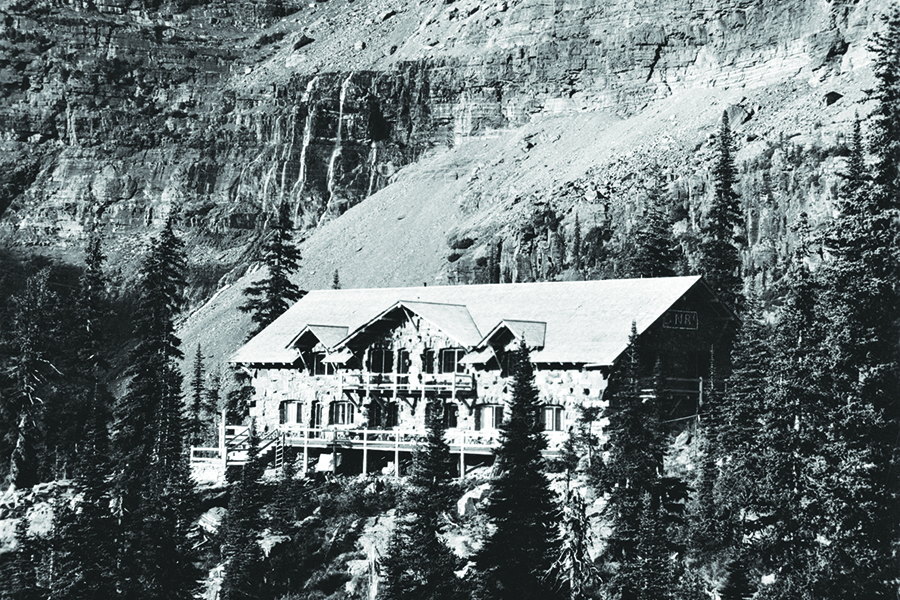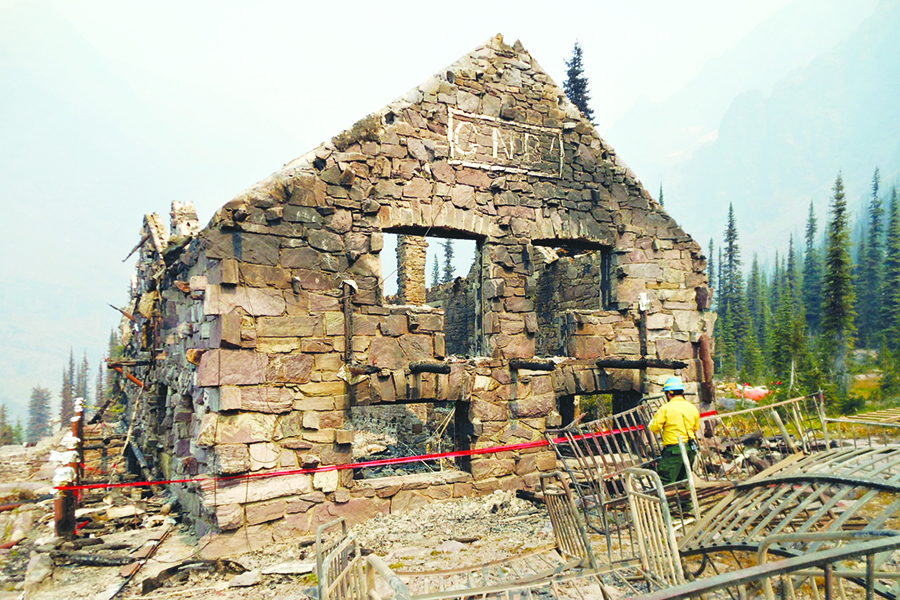The Race to Rebuild
Facing mounting pressure from Washington, D.C. and the public, a streamlined effort to reconstruct the fire-gutted Sperry Chalet in Glacier National Park is underway. A quarter-century ago, similar pressures led to a million-dollar outhouse and the renovation of a national gem
By Tristan Scott
Two decades ago, work crews put the finishing touches on a million-dollar commode in the upper reaches of Glacier National Park, a project that took three summers to complete at Sperry Chalet, the historic backcountry lodge perched on a rocky ledge just below the Continental Divide, nearly 3,500 feet above Lake McDonald.
It was a pricy privy for the beleaguered National Park Service, but the nation demanded it.
Between 1914 and 1992, visitors who wanted to spend a starry night in the backcountry didn’t have to lie in a tent worrying about grizzly bears and mountain storms. For a chunk of change and a coveted reservation made months in advance, weary hikers could bunk in the lap of luxury amid eye-popping alpine scenery.
To some hearty hikers, that might seem a little extravagant for a wilderness experience, but when the National Park Service moved to close Sperry, its widespread popularity became abundantly clear.
Regulatory changes since the chalet’s construction in 1913 rendered Sperry’s sewage system woefully inadequate by 1992, forcing the National Park Service to design an alternative plan — either do away with the menu of traditional concessioner services furnished on visitors to the remote lodge, including hot meals, a la carte snacks, cold lemonade, overnight lodging with bedding and linen, and flush toilets, or rebuild the chalet to meet modern standards.
In response to environmental groups and water quality officials crying foul over the faulty septic systems, as well as the park’s process of discharging a summer’s worth of waste in the surrounding area each fall, the National Park Service closed Sperry and its sister chalet at Granite Park following the 1992 summer season.

Even then, the National Park Service chafed under the constraints of budget shortfalls and a swollen maintenance backlog, and Glacier Park administers did not view the chalets as a priority.
“We have far greater needs,” Superintendent Dave Mihalic told USA Today in 1997.
Still, the closures angered hikers and other chalet devotees, and a grassroots group, Save the Chalets, formed to lobby the state’s congressional delegation for their revival. Led by Wayne Phillips, the group lobbied U.S. Sen. Max Baucus, a Democrat, and U.S. Sen. Conrad Burns, a Republican member of the appropriations subcommittee that controls Park Service spending.
The lobbying campaign succeeded. In 1993, Congress appropriated the initial funds for a renovation project — $3.3 million for both chalets, complete with plans for high-elevation composting toilets.
“If somebody handed me $2.5 million and asked, ‘where would you best put it?,’ the chalets would be far down the list. The problem is, no one did it that way,” Mihalic said, according to the USA Today article. “Congress handed us $3.3 million and said, ‘put it here.’”
Meanwhile, the Park Service considered several preservation alternatives. One plan would have cost only $661,000, but the chalets would not have been reopened to the public.
In 1994, the agency opted for the more expensive alternative of returning the chalets to traditional use. Because all of the supplies had to be brought in by horse or helicopter, the project proved even more costly than anticipated. Initial estimates pegged the renovations of both chalets at $4.6 million, but in the end it required an additional $2 million to complete.

With initial appropriations totaling $3 million by 1995, work began first at Granite Park Chalet, with Sperry’s future contingent on additional funding.
The overhaul of Sperry began in 1996, with the lion’s share of the money sunk into hundreds of helicopter flights required to ferry in thousands of pounds of materials, according to an environmental assessment, as well as to navigate the Park Service’s leave-no-trace constraints inside a proposed wilderness area and pack as much work as possible into the narrow summer season, with crews battling snow on either end.
Workers blasted and hand dug holes for septic tanks, sand filters and drain fields, hauling tons of rock out of the holes by helicopter and depositing it on a nearby scree slope so as to avoid crushing native vegetation.
For every dollar of material, the project required an addition $1.60 in helicopter costs as pilots logged approximately 150 hours transporting supplies across the rugged terrain, taking care to avoid eagle migration corridors.
By 1998 the work was complete, and the following year Sperry Chalet reopened as a full-service lodge, catering to 42 visitors a night for nine weeks every summer. For the past five years Sperry Chalet has accommodated an approximate average of 2,340 overnight guests each year, or just .07 percent of the record 3,305,513 visitors who flocked to Glacier Park in 2017.
And then came the Sprague Fire.
The 104-year-old Sperry Chalet was lost on Aug. 31, 2017 after the 17,000-acre wildfire doubled in size in a matter of hours, destroying its fir-and-lodgepole framework and leaving behind only the native-rock shell hewed from a nearby mountain quarry by Italian stone masons.

Five firefighters and four helicopters made what National Park Service officials called a “valiant” effort to save the National Historic Landmark, but in the end those efforts fell short.
The main two-story dormitory was destroyed, while a number of outbuildings were saved, including the stone kitchen, dining room, and a state-of-the-art outhouse with four composting toilets.
As photos of the burning building and smoldering rock walls circulated, the public reacted with shock and grief.
“I am utterly devastated that our beloved Chalet has been lost to the Sprague fire,” Geneva Warrington, a member of the extended Luding family, which for 63 years operated the chalet, posted on Instagram.
Now, facing mounting pressure from Washington, D.C. and the public, a streamlined effort to completely reconstruct the fire-gutted Sperry Chalet over the next two years is underway.
Much of the project’s urgency can be traced back to U.S. Secretary of the Interior Ryan Zinke, a Whitefish native and former U.S. representative, who responded unequivocally to Sperry’s loss by pledging a swift rebuild.
“Rebuilding Sperry is one of my top priorities,” Zinke said, a sentiment shared by Montana’s three-person congressional delegation.
Glacier National Park Superintendent Jeff Mow acknowledged the timeframe is tight and the construction schedule, slated to begin July 1 and continue to the end of October, will likely be affected by weather.
“This whole thing is being expedited,” Mow recently told business leaders gathered for a Whitefish Chamber of Commerce breakfast. “Interior Secretary Ryan Zinke has said that he would like us to pursue a plan that looks at rebuilding this over the course of two years, which is fast. But the goal is to get Sperry up and running as soon as possible.”
Although estimating a precise budget for the rebuild is an inexact science, Mow ball-parked a range of between $8 million and $12 million, with helicopter flights alone projected to cost $1 million. Funding will be a “public-private venture,” park officials said.
Last summer, the Glacier National Park Conservancy, the park’s official nonprofit fundraising partner, raised $120,000 to stabilize Sperry’s stone shell, and the agency has pledged an additional $2 million to the rebuild this summer.
“It’s a big lift,” Doug Mitchell, the Conservancy’s executive director, said. “It kind of makes me sweat. But the Sperry story is a remarkable one.”
Prior to Sperry’s destruction, the Glacier Park Conservancy had identified 48 projects inside the park requiring more than $2 million in funding. The 49th project, rebuilding Sperry, effectively doubled the Conservancy’s fundraising goal.
But according to Mitchell, the initial donations poured in from “all 50 states and around the world almost without having to ask,” underscoring the rich connection that visitors have with Sperry.
The Swiss-style chalet was built in 1913 by the Great Northern Railroad and opened to visitors the following year, one of eight chalets scattered around the park. Eastern “dudes” could travel the backcountry for a week straight, stopping each night for a gourmet meal served on fine china. They ate with shining silver flatware before bunking down on featherbeds draped in Chinese linen.
Although the National Park Service operates 417 units on a budget of only $2 billion while facing a staggering $12 billion backlog of construction and maintenance, the Sperry Chalet and the attendant “Sperry Experience” it offers to some visitors has triumphed over pragmatic belt-tightening, and for the majority of the members of the public who commented on the plan for Sperry’s future, that’s just fine.
For those who have enjoyed the “Sperry Experience,” or even visited the site, the chalet has left an indelible impression, as evidenced by the more than 400 public comments that poured in during the park’s scoping period conducted from Feb. 28 to April 2.

Approximately 72 percent of commenters favored some combination of two concepts proposed by the National Park Service, which outlined scenarios to use the existing remnant walls of the Sperry Chalet dormitory building to rebuild it with some modernization, while retaining defining historic features and character.
Much smaller percentages of commenters favored proposals to construct a new dormitory in a different location away from hazardous avalanche paths while preserving the exterior stone walls as an historic ruin, or to offer overnight accommodations in tent-like structures.
The impacts of the project will be significant to Sperry’s surroundings and the critters who inhabit them, but a recent environmental assessment says in most cases they will be “temporary and transitory,” including noise pollution that could compromise the visitor experience as a result of construction activities, helicopter flights, and human presence, which will drive away wildlife during the periods of activity.
A crew of between 12 and 25 workers will live onsite in temporary tents while helicopters and pack strings ferry supplies weighing up to 400,000 pounds to the remote location, located six miles by trail above the Going-to-the-Sun Road.
Another consideration is piloting helicopters through a raptor migration corridor that each September supports 2,000 hawks, falcons, eagles, and accipiters, according to the environmental assessment.
During the first phase of construction, the environmental assessment estimates that approximately 150-220 helicopter trips (depending on the size of the helicopter) are required to transport construction materials. There will likely be days of 40-50 flights and other days with fewer or no flights.
Approximately 35-60 pack-string trips will transport the remaining construction materials and food for the crews for phase one.
The second phase of construction is slated run from June 1 to Oct. 30, 2019, and will require a similar size crew and support. Approximately 200-300 helicopter flights would transport construction materials that could not be brought in by stock, while 35-60 pack-string trips would transport the remaining materials and food.
As Mitchell said, it’s a big lift, and a worthy one to many, but not all, visitors.
At a public meeting last month, resident Bill Baum said the project compromises the wilderness experience Glacier is meant to preserve, and will displace grizzly bears. Others have said the exorbitant price tag would be better applied to infrastructure needs like road improvements, sewers and shuttle buses as the park prepares for another busy summer season, which is expected to usher in record-breaking crowds for the fifth consecutive year.
Michael Jamison, head of the National Parks Conservation Association’s Glacier Field Office, said he doesn’t oppose rebuilding Sperry Chalet, but he does take umbrage with the lack of planning and reason that influence the project’s expedited pace, particularly given the minuscule number of visitors the chalet serves compared to the masses its reconstruction will disturb.
“There are head projects and there are heart projects,” Jamison said. “And this is definitely a heart project.”